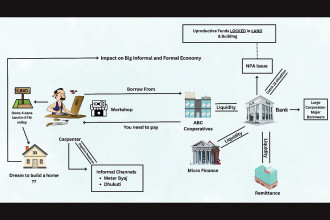
Setting up a factory in Nepal can be a promising venture given the country’s strategic location between two large markets, India and China. However, establishing a factory in Nepal requires careful consideration of various factors due to the nation’s unique challenges and limited resources. This article will explore the important factors to consider, the types of factories suitable for Nepal, the challenges faced, and effective marketing strategies for products post-production.
IMPORTANT FACTORS TO CONSIDER
Government Policies and Regulations
Understanding Nepal’s industrial policies and regulations is crucial for establishing a factory. The government has introduced several policies to encourage industrialisation such as tax incentives, import duty exemptions, and the establishment of industrial zones. Familiarise yourself with the Industrial Policy of 2010, which emphasises joint efforts between the public, private and cooperative sectors to promote industrial growth.
Tax Incentives: The government offers tax holidays and reduced tax rates for certain industries, particularly those located in less developed areas. These incentives can significantly reduce the initial financial burden on new factories.
Import Duty Exemptions: Factories importing machinery and raw materials may benefit from reduced or exempt import duties, lowering the cost of production.
Industrial Zones: The establishment of industrial zones, such as the Balaju Industrial Estate and Hetauda Industrial Estate, provides essential infrastructure and services, reducing the logistical challenges of setting up a factory.
Location and Infrastructure
Choosing the right location is vital for the success of a factory in Nepal. Most industries in Nepal are concentrated in the Terai region due to better road connectivity, access to electricity, and proximity to the Indian border.
Road Connectivity: Good road networks are essential for the transportation of raw materials and finished goods. The Terai region offers better connectivity compared to the hilly and mountainous areas.
Electricity Supply: Consistent access to electricity is crucial for manufacturing operations. Industrial zones often have dedicated power supplies, minimising the risk of power outages.
Proximity to Markets: Being close to the Indian border allows for easier access to a large market and simplifies export processes.
Availability of Resources:
Assess the availability of raw materials and other resources. Nepal’s diverse geography offers resources like hydropower, minerals and agricultural products. However, the lack of local raw materials for certain industries can be a significant challenge. For instance, while there is an abundance of agricultural produce, the country may lack other essential industrial raw materials, necessitating imports which can increase costs and complicate logistics.
Skilled Workforce:
Ensure access to a skilled workforce. Nepal faces a shortage of skilled labour which can hinder the productivity and efficiency of factories. Investing in training and development programmes is essential to mitigate this issue. Establishing vocational training centres and collaborating with educational institutions can help develop the necessary skills among the local population, thereby ensuring a steady supply of qualified workers.
CHALLENGES IN ESTABLISHING A FACTORY
Geographical and Infrastructural Constraints
Nepal’s rugged terrain and underdeveloped infrastructure pose significant challenges. The difficult geographical structure makes transportation and logistics a major hurdle. Additionally, there is a lack of adequate social infrastructure such as health facilities and sanitation, which can affect the overall quality of life for employees and their families, further complicating industrial operations.
Political Instability
Political instability and frequent changes in government policies can disrupt business operations. The lack of a stable political environment affects investor confidence and long-term planning. Businesses must navigate through periods of political uncertainty, which can impact everything from regulatory frameworks to the enforcement of laws and contracts.
Bureaucratic Inefficiencies: Delays in obtaining permits, licences and approvals increase costs and hinder project completion.
Unpredictable Policy Changes: Revoked incentives with government changes cause unexpected financial strain.
Investor Confidence: Erodes confidence, making it hard to attract investment; investors prefer stable, predictable environments.
Social Unrest and Strikes: Disrupts operations and supply chains, leading to production halts and financial losses.
Corruption and Nepotism: Increases operational costs and legal risks due to unethical practices like bribery.
Mitigation Strategies: Diversify investments, maintain operational flexibility, form local partnerships, and invest in political risk insurance.
Financial Constraints
Limited access to capital and financial institutions is another major challenge. High-interest rates and stringent lending conditions make it difficult for entrepreneurs to secure necessary funding for establishing factories. Additionally, the underdeveloped financial market in Nepal means that businesses have fewer options for raising capital through instruments like bonds or equity.
High-Interest Rates: Increases borrowing costs and debt management challenges.
Stringent Lending Conditions: Strict requirements make qualifying for loans difficult.
Underdeveloped Financial Market: Limited options for raising capital through bonds or equity.
Limited Investment Opportunities: Few venture capital and private equity firms.
Cash Flow Management: Difficulty in managing cash flow due to lack of accessible credit facilities.
Mitigation Strategies: Explore alternative funding sources, build relationships with local financial institutions, and improve financial literacy.
Regulatory Hurdles
Navigating through complex regulatory frameworks and obtaining necessary permits and licences can be time-consuming and bureaucratic. Simplifying these processes is essential for fostering a conducive business environment. Entrepreneurs must deal with various government agencies, which can delay the setup process and increase the cost of compliance.
TYPES OF FACTORIES SUITABLE FOR NEPAL
Given Nepal’s limited resources and infrastructural challenges, certain types of factories are more viable:
Agro-based Industries
Agro-based industries, such as processing plants for tea, coffee and herbs are highly suitable. Nepal’s diverse climate allows for the cultivation of various crops, making it an ideal location for such industries. These industries can capitalise on the country’s agricultural strengths and add value to raw agricultural products, boosting both local and export markets.
Diverse Crop Cultivation: Utilise Nepal’s varied climate to grow a range of crops, from tea and coffee to herbs.
Value-Added Products: Enhance the economic value by processing raw agricultural products into market-ready goods.
Export Potential: Develop products that meet international standards for export, opening new markets globally.
Rural Employment: Generate employment opportunities in rural areas, helping to reduce urban migration.
Organic Farming: Promote organic farming practices to meet the growing demand for organic products worldwide.
Hydropower Plants
Nepal has significant hydropower potential, with numerous rivers and waterfalls. Setting up small to medium-sized hydropower plants can be highly beneficial and sustainable. These plants can provide a reliable source of energy for other industries and help reduce the country’s reliance on imported fossil fuels.
Micro-Hydro Projects: Develop small-scale, community-driven hydro projects to support local energy needs.
Export Electricity: Explore the potential of exporting surplus electricity to neighbouring countries, such as India and China.
Green Energy: Position Nepal as a leader in renewable energy by focusing on clean, sustainable hydropower.
Local Partnerships: Partner with local communities and international investors to fund and operate hydropower plants.
Infrastructure Development: Utilise hydropower projects to improve local infrastructure, such as roads and bridges.
Tourism-related Industries
Factories producing goods for the tourism industry, such as handicrafts, textiles and traditional Nepali products, can thrive. These industries leverage Nepal’s rich cultural heritage and attract tourists seeking authentic products. By focusing on high-quality, culturally significant items, these factories can tap into both local and international markets.
Cultural Workshops: Establish workshops where tourists can see and participate in the creation of traditional handicrafts.
Online Presence: Create e-commerce platforms to sell products globally, enhancing reach beyond physical tourism.
Certified Authenticity: Develop a certification programme to assure tourists and buyers of the authenticity and quality of Nepali products.
Collaborations: Work with local artisans and designers to innovate and preserve traditional craftsmanship.
Tourist Packages: Bundle products with tourism packages, offering exclusive, limited-edition items as part of the travel experience.
Light Manufacturing
Light manufacturing industries, including textiles, garments and consumer goods, can be established with relatively lower capital investment and infrastructure requirements. These industries can benefit from the availability of labour and proximity to large markets in India and China.
Textile Hubs: Develop dedicated textile hubs that provide shared facilities and resources to small manufacturers.
Skill Development Programmes: Implement training programmes to improve the skill set of the workforce in light manufacturing.
Export Processing Zones: Create zones with tax incentives and streamlined regulations to encourage export-oriented manufacturing.
Customisable Products: Focus on producing customisable and niche market products to cater to specific customer needs.
Technology Integration: Integrate modern manufacturing technologies to improve efficiency and product quality.
Form partnerships with local distributors, retailers and exporters to expand your market reach. Collaborating with established businesses can provide valuable market insights and distribution channels. Strategic partnerships can help in overcoming logistical challenges and accessing new customer segments.
MARKETING YOUR PRODUCTS
Effective marketing strategies are essential for the success of any factory. Here are some key approaches:
Leveraging Digital Platforms
Utilise digital marketing platforms to reach a broader audience. Social media, e-commerce websites, and online marketplaces like Vistaar Trade can help promote products both locally and internationally. Digital marketing can be a cost-effective way to reach a large audience and build brand awareness quickly.
Targeted Advertising: Use social media platforms like Facebook and Instagram for targeted advertising to specific demographics.
SEO Optimisation: Optimise your website and product listings for search engines to increase organic traffic.
Influencer Collaborations: Partner with local influencers to promote your products and enhance credibility.
Email Marketing: Build an email list to directly reach customers with promotions and updates.
Building Brand Awareness
Invest in building a strong brand presence. This can be achieved through consistent branding, quality products and engaging marketing campaigns. Participating in trade fairs and exhibitions can also enhance visibility. A strong brand can differentiate your products in a competitive market and foster customer loyalty.
Brand Storytelling: Develop a compelling brand story that resonates with customers.
Customer Engagement: Use social media to interact with customers, respond to feedback, and build a community.
Content Marketing: Create informative and engaging content about your products and industry to attract and educate potential customers.
Brand Ambassadors: Identify and partner with brand ambassadors who align with your values and can advocate for your products.
Forming Strategic Partnerships
Form partnerships with local distributors, retailers and exporters to expand your market reach. Collaborating with established businesses can provide valuable market insights and distribution channels. Strategic partnerships can help in overcoming logistical challenges and accessing new customer segments.
Joint Ventures: Enter into joint ventures with local businesses to share resources and expertise.
Cross-Promotions: Collaborate with other brands for cross-promotional activities to reach a wider audience.
Local Market Penetration: Partner with local retailers to ensure your products are available in key markets.
Export Partnerships: Form alliances with export agencies to streamline the process of entering international markets.
Focusing on Quality and Innovation
Ensure that your products meet high-quality standards and continuously innovate to stay competitive. Offering unique and high-quality products can differentiate your factory from competitors. Investing in research and development can help create innovative products that meet changing consumer demands.
Quality Assurance Programmes: Implement rigorous quality control processes to ensure product excellence.
Customer Feedback Loop: Regularly collect and analyse customer feedback to drive product improvements.
Innovative Design: Invest in innovative design and technology to create products that stand out in the market.
Sustainable Practices: Incorporate sustainable practices in your production process to appeal to environmentally conscious consumers.
Conclusion
Establishing a factory in Nepal offers significant opportunities but it comes with its own set of challenges. By carefully considering government policies, location, resource availability, and workforce training, you can set a strong foundation for your factory. Addressing the challenges related to geography, political stability, financial constraints, and regulatory hurdles is essential for long-term success. Choosing suitable industries and implementing effective marketing strategies will ensure that your products reach the right audience and achieve commercial success.






-1758271497.jpg)